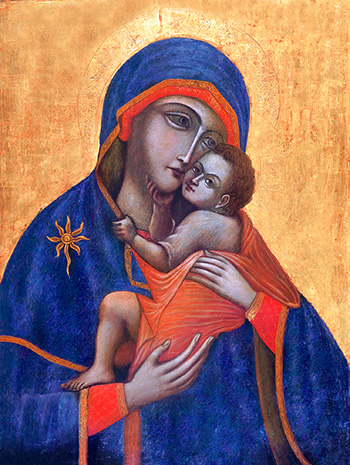 Signs in ordinary human life
Signs in ordinary human life
The world in which we live is full of material things which have symbolic meaning: light, fire, water...
There are also, in everyday life, experiences of relationships between human beings, which express and symbolise deeper realities such as sharing a meal (as a sign of friendship), taking part in a protest march (as a sign of solidarity), joining together in a national celebration (as a sign of identity).
We need signs and symbols to help us understand what is happening at present, or what happened before, and to give us an awareness of who we are, as individuals and as groups.
Signs in Christian life
Jesus is the great sign and gift of the Father’s love. He founded the Church as a sign and instrument of his love. Christian life also has its signs. Jesus used bread, wine, and water, to help us understand higher things, which we can neither see nor touch.
In the celebration of the Eucharist and the other sacraments (Baptism, Confirmation, Reconciliation, Matrimony, Holy Orders, the Sacrament of the Sick) the symbols, (water, oil, the laying on of hands, the rings), all have their own meaning and bring us into communication with God, present in each of them.
As well as liturgical signs, the Church has others related to some event, to some tradition, or some person. One of these is the Brown Scapular of Our Lady of Mount Carmel.
The Scapular is a sign of Mary
One of the signs in the tradition of the Church from many centuries ago is the Brown Scapular of Our Lady of Mount Carmel. It is a sign approved by the Church and accepted by the Carmelite Order as an external sign of love for Mary, of the trust her children have in her, and of commitment to live like her.
The word scapular indicates a form of clothing which monks wore when they were working.
With the passage of time, people began to give symbolic meaning to it: the cross to be borne every day as disciples and followers of Christ. In some religious orders, such as the Carmelites, the Scapular turned into a sign of their way of life. The Scapular came to symbolise the special dedication of Carmelites to Mary, the Mother of God, and to express trust in her motherly protection as well as desire to be like her in her commitment to Christ and to others. Thus it became a sign of Mary.
From Religious Orders to the People of God
In the middle ages many Christians wanted to be associated with the Orders founded at that time: Franciscans, Dominicans, Augustinians and Carmelites. Groups of lay people began to emerge in associations such as confraternities and sodalities.
All the religious Orders wanted to give these lay people a sign of affiliation and of participation in their spirit and apostolate. That sign was often a part of their habit: a cloak, a cord, a scapular.
Among the Carmelites, the stage came when a smaller version of the Scapular was accepted as the sign of belonging to the Order and an expression of its spirituality.
The value and meaning of the Scapular
The Scapular finds its roots in the tradition of the Order, which has seen in it a sign of Mary’s motherly protection. It has, therefore, a centuries old spiritual meaning approved by the Church:
It stands for a commitment to follow Jesus, as did Mary, the perfect model of all the disciples of Christ. This commitment finds its origin in baptism by which we become children of God.
The Blessed Virgin teaches us,
- to be open to God, and to his will shown to us in the people, circumstances and events of our lives;
- to listen to the Word of God in the bible and in life, to believe in it and to put into practice its demands;
- to pray always,as a way of discovering the presence of God in all that is happening around us;
- to be involved with people, being attentive to their needs.
It leads us into the community of Carmel, a community of religious and lay men and women, which has existed in the Church for eight centuries. It calls on us to live out the ideal of the Carmelite family: intimate friendship with God in prayer.
It reminds us of the example of the saints of Carmel, with whom we establish a close bond as brothers and sisters to one another.
It is an expression of our belief that we will meet God in eternal life, aided by the intercession and prayer of Mary.
Some practical rules
People are enrolled in the Scapular only once, by a priest or authorised person.
The Scapular can be replaced afterwards by a medal which has on one side the image of the Sacred Heart of Jesus and on the other the image of Mary.
The Scapular holds us to live as authentic Christians in line with the teaching of the Gospel, to receive the sacraments, to profess our special friendship for Mary, which should be expressed each day – for example, by praying the Hail Mary, prayerful reading of the Scriptures, service to someone in need.
The Carmelite Scapular
is not:
- a magical charm to protect you
- an automatic guarantee of salvation
- an excuse for not living up to the demands of Christian life;
it is:
A Sign which
stands for the decision to follow Jesus as Mary did:
- open to God and to God's will,
- guided by faith, hope and love,
- close to the needs of people,
- praying always,
- discovering God present in our life;
brings people into the family of Carmel;
with Mary's help, strengthens our desire to be with God forever.














